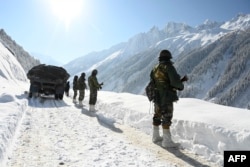Chinese President Xi Jinping and Indian Prime Minister Narendra Modi stressed the need to boost cooperation between the two countries on Wednesday during the first bilateral meeting held between the two leaders in five years.
The meeting between Xi and Modi, held on the sidelines of the BRICS summit in the Russian city of Kazan, signaled a thaw in the icy hostility that has marked ties between the Asian giants since a bloody border clash between their armies in 2020.
Televised images showed the two leaders shaking hands before they went into the meeting. It took place days after their governments announced an accord that is expected to ease military tensions along the disputed frontier where tens of thousands of soldiers have been massed on a war footing since the 2020 clash.
“The two sides should strengthen communication and cooperation, properly handle divergences and differences, and realize each other’s development dreams,” Chinese state broadcaster CCTV quoted Xi as saying at the start of the meeting. He said that it was important for both sides to “shoulder our international responsibilities.”
“It should be our priority to maintain peace and tranquility on the border,” Modi said. “Mutual trust, mutual respect and mutual sensitivity should be the basis of our relationship.”
A statement by the Indian Foreign Ministry said the two leaders affirmed that stable, predictable and amicable bilateral relations between India and China will have a positive impact on regional and global peace and prosperity.
Indian Foreign Secretary Vikram Misri told reporters after the meeting that the endorsement of the recent agreement by the two leaders will lead to an easing of the situation along their frontier.
“Peace in the border areas will create space for returning toward normalization of ties,” Misri said. “Now we must walk along that path.”
The pact announced earlier this week involves allowing militaries from both sides to patrol contested sections of their Himalayan border. It aims at preventing border clashes and ensuring that the countries can “quickly de-escalate” when there are disputes, according to Indian officials.
China said on Tuesday that Beijing would work in the next stage to “properly implement the plan with the Indian side.”
In the last four years, both countries have withdrawn troops from some disputed areas after talks between their diplomats and military leaders, but there has been no breakthrough in reducing border tensions. On the other hand, both countries have raced to build roads and strengthen infrastructure in the high Himalayas, where the troops are backed by fighter jets and artillery tanks.
It is not clear if there will be any withdrawal of troops from the border areas, but the accord is seen as a first step in ending the military standoff.
The 2020 border clash killed 20 Indian and four Chinese soldiers. Smaller clashes took place in 2021 and 2022, raising fears of bigger clashes between troops in close proximity along disputed stretches of their 4,000-kilometer Himalayan border.
Modi held brief meetings with Xi in Indonesia on the sidelines of the Group of 20 meeting in 2022 and the BRICS summit in Johannesburg last year, but the two leaders had not held a bilateral meeting since 2019. Xi did not attend the Group of 20 meeting hosted by India last year.
Political commentators in India called Wednesday’s meeting significant.
“It marks a major step in trying to normalize ties between the two countries,” said Manoj Joshi at the Observer Research Foundation in New Delhi. “Both countries are trying to lower the temperatures, but of course there is still a long distance to go.”
India’s estrangement with China in recent years had prompted New Delhi to build closer defense and economic ties with the United States and Western countries.

